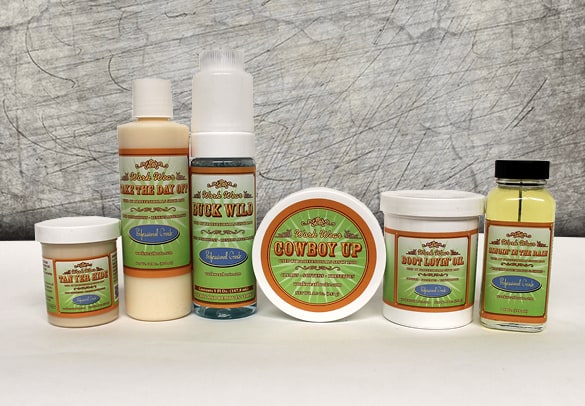Keep Your Boots Looking as Good as They Make You Feel
DAY 1
When you first get your new boots, wear them around the house on the carpet for a day or two to break them in and ensure the fit is best for you. This does two things for you: first, it allows the footwear to be flexed in and ready for work. And second, it ensures your foot is properly aligned with the comfort and safety technology in the footwear.

CLEANING AND MAINTENANCE TIPS
To aid you in the care of your new safety shoes or boots, we have created a line of products designed with your work environments in mind.
Here is the list of products and their purposes along with links to videos on how to use them properly.
Take The Day Off
This one is for cleaning any type of leather. Think of it as shampoo for your shoes.
Cowboy Up
Our version of saddle soap that cleans, softens and preserves smooth leathers. Removes wax build-up on smooth leather.
Tan Yer Hide
Conditions, protects and preserves all oil-tanned and waxed leathers. Renews appearance and restores oils to leather.
Boot Lovin Oil’
This is our version of mink oil. It preserves smooth leathers and vinyls against stains, drying, and cracking.
Singin’ In The Rain
This is our version of a liquid silicone. It prevents water penetration on smooth leathers and waterproof materials.
Buck Wild
This is our specially formulated cleaner for all types of suede and nubuck products. It cleans and removes stains.
MORE FOOTWEAR CARE TIPS
WHAT IS "DRY ROT" AND HOW DO I PREVENT IT?
You just got your voucher for your new pair of safety shoes or boots, but your current ones still have a lot of life in them. So, you put the new ones in the closet and wait to get them out. Bad idea!
You may think leaving your new work boots in the box with all its packaging is good for it. But the exact opposite is true Most work boots use a rubber compound in the outsole. This compound is very durable, soft under foot and resists high temperatures. But if not put into use, it will decay. People often refer to this as “dry rot” and while technically this is not what’s happening – it is the most common term.
Dry rot refers to a fungus getting onto the boot. In the case of work boots, while the result is the ssme, the reason is very different. Rubber, whether natural or synthetic, is a polymer and its chains of molecules are vulnerable to many of the same factors that affect all polymers — ultraviolet radiation, temperature extremes, ozone, oxidation and in the case of safety shoes darkness and lack of movement or flexing. Rubber that gets regular use will retain its flexibility and molecular properties longer than neglected rubber. For example, the shoes you wear regularly are actually more resistant to rot than ones hidden away “ efe” in your closet. During the manufacturing process, a protective compound is added to the rubber formulation. Regular use causes the shoe or boot to flex and compress, pushing this protective substance to the surface. This doesn’t happen in an unused shoe or boot, so the rubber is more vulnerable to damage from ozone and oxidation – in other words “dry rot.”
Shoes subject to this condition will void the warranty of the manufacturer and Work Wear Safety Shoes. So make sure you get those new boots out of the box and into use right away!
WHAT DOES PROPER "FIT" MEAN?
Proper fit means that the widest part of the foot is in the widest part of the shoe or boot. This ensures that the boot flexes naturally versus your foot having to move it. It also extends the life of the boot and ensures that all fo that comfort technology in the midsole is aligned with your foot appropriately.